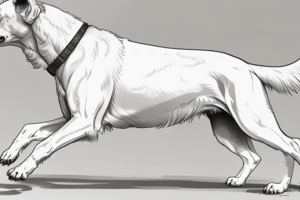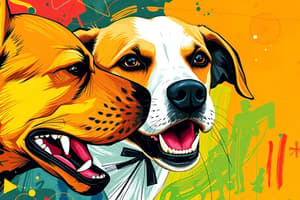Podcast
Questions and Answers
What is the primary definition of aggression in dogs?
What is the primary definition of aggression in dogs?
- The intent to defend territory
- The intent to be protective
- The intent to interact positively with others
- The intent to do harm (correct)
Which factor is NOT contributing to the likelihood of developing dog aggression?
Which factor is NOT contributing to the likelihood of developing dog aggression?
- Low exercise levels (correct)
- Anxiety or phobia
- Lack of structure
- Traumatic experience
At what age does dog aggression commonly manifest?
At what age does dog aggression commonly manifest?
- During their first few weeks
- From birth to six months
- At six months to four years (correct)
- After four years
Which behavior is commonly mistaken for dominance aggression?
Which behavior is commonly mistaken for dominance aggression?
Why might excessive play behavior be concerning in young dogs?
Why might excessive play behavior be concerning in young dogs?
Which medical condition is listed as a possible cause of aggressive behavior in dogs?
Which medical condition is listed as a possible cause of aggressive behavior in dogs?
Which situation could trigger displays of aggression in dogs?
Which situation could trigger displays of aggression in dogs?
Which statement about exercise and aggression in dogs is correct?
Which statement about exercise and aggression in dogs is correct?
What is the primary cause of redirected aggression in dogs?
What is the primary cause of redirected aggression in dogs?
In what situation might a dog exhibit territorial aggression?
In what situation might a dog exhibit territorial aggression?
How should resource guarding behavior be managed in dogs?
How should resource guarding behavior be managed in dogs?
What is a common misconception regarding a resource guarding dog?
What is a common misconception regarding a resource guarding dog?
What should be done if a dog gets hold of an object it is not supposed to have?
What should be done if a dog gets hold of an object it is not supposed to have?
How might a dog's past experiences influence redirected aggression?
How might a dog's past experiences influence redirected aggression?
Which of the following is a characteristic of territorial aggression?
Which of the following is a characteristic of territorial aggression?
What is an effective strategy for preventing a dog from practicing food guarding behavior?
What is an effective strategy for preventing a dog from practicing food guarding behavior?
What can maternal aggression in dogs indicate?
What can maternal aggression in dogs indicate?
Which symptom is NOT associated with hormonal aggression in dogs?
Which symptom is NOT associated with hormonal aggression in dogs?
What medical condition is NOT linked to aggressive behavior in dogs?
What medical condition is NOT linked to aggressive behavior in dogs?
What might be a necessary approach for a dog that exhibits aggression due to pain?
What might be a necessary approach for a dog that exhibits aggression due to pain?
Which breed is NOT identified as prone to behavioral seizures?
Which breed is NOT identified as prone to behavioral seizures?
Which statement about idiopathic aggression is true?
Which statement about idiopathic aggression is true?
What behavior might indicate that a mother dog is experiencing maternal aggression?
What behavior might indicate that a mother dog is experiencing maternal aggression?
What behavioral change is typically NOT expected during a female dog’s heat cycle?
What behavioral change is typically NOT expected during a female dog’s heat cycle?
What is a potential consequence of using leash corrections or shock collars on dogs?
What is a potential consequence of using leash corrections or shock collars on dogs?
Why are dominance-based approaches in dog training considered controversial?
Why are dominance-based approaches in dog training considered controversial?
What is reactivity in dogs defined as?
What is reactivity in dogs defined as?
What is a common behavior exhibited by reactive dogs when they encounter other dogs?
What is a common behavior exhibited by reactive dogs when they encounter other dogs?
What can happen if aggressive displays, like growling, are punished?
What can happen if aggressive displays, like growling, are punished?
What role does early socialization play in preventing dog-to-dog aggression?
What role does early socialization play in preventing dog-to-dog aggression?
What is the primary goal of possession exchanges during training?
What is the primary goal of possession exchanges during training?
Which of the following factors can contribute to dog-to-dog aggression?
Which of the following factors can contribute to dog-to-dog aggression?
When addressing food guarding behavior, what is the first step to take?
When addressing food guarding behavior, what is the first step to take?
What is the recommended approach to training dogs that exhibit reactive behavior?
What is the recommended approach to training dogs that exhibit reactive behavior?
Why is physical punishment considered dangerous when training dogs with food guarding issues?
Why is physical punishment considered dangerous when training dogs with food guarding issues?
What is a potential outcome for dogs that exhibit serious aggressive behaviors towards others?
What is a potential outcome for dogs that exhibit serious aggressive behaviors towards others?
What characterizes predatory aggression in dogs?
What characterizes predatory aggression in dogs?
How does maternal aggression primarily manifest in mother dogs?
How does maternal aggression primarily manifest in mother dogs?
What should be avoided when implementing a DS/CC program for dog training?
What should be avoided when implementing a DS/CC program for dog training?
Which factor differentiates predatory aggression from territorial aggression?
Which factor differentiates predatory aggression from territorial aggression?
What is the recommended approach if a dog shows signs of discomfort during food guarding training?
What is the recommended approach if a dog shows signs of discomfort during food guarding training?
What should you avoid when training a dog about possession exchanges?
What should you avoid when training a dog about possession exchanges?
What is a sign that a dog is exhibiting territorial aggression rather than predatory aggression?
What is a sign that a dog is exhibiting territorial aggression rather than predatory aggression?
What outcome does the practice of possession exchanges aim to achieve for dogs?
What outcome does the practice of possession exchanges aim to achieve for dogs?
What is the first step in rehabilitating a reactive dog?
What is the first step in rehabilitating a reactive dog?
Why is it important to keep a reactive dog under threshold during training?
Why is it important to keep a reactive dog under threshold during training?
What does counter commanding involve when rehabilitating a reactive dog?
What does counter commanding involve when rehabilitating a reactive dog?
What does systematic desensitization refer to in the context of dog training?
What does systematic desensitization refer to in the context of dog training?
What is referred to as spontaneous recovery in reactive dogs?
What is referred to as spontaneous recovery in reactive dogs?
Which method is NOT mentioned as a treatment for leash reactivity?
Which method is NOT mentioned as a treatment for leash reactivity?
What must a dog learn to associate with the presence of another dog during rehabilitation?
What must a dog learn to associate with the presence of another dog during rehabilitation?
What is an essential component to include in a rehabilitation program for reactive dogs?
What is an essential component to include in a rehabilitation program for reactive dogs?
What is a potential side effect of punishment in dog training?
What is a potential side effect of punishment in dog training?
Which behavior may result from a dog experiencing punishment?
Which behavior may result from a dog experiencing punishment?
What is an example of abusive treatment towards a dog?
What is an example of abusive treatment towards a dog?
What type of aggression is typically exhibited by most dogs?
What type of aggression is typically exhibited by most dogs?
What is a common underlying cause of aggression in dogs that have experienced trauma?
What is a common underlying cause of aggression in dogs that have experienced trauma?
Which method is often used to help reduce fear-based aggression in dogs?
Which method is often used to help reduce fear-based aggression in dogs?
Which statement best describes the Cochrane & Area Humane Society's stance on dog aggression?
Which statement best describes the Cochrane & Area Humane Society's stance on dog aggression?
What is one reason owners may become abusive towards their dogs?
What is one reason owners may become abusive towards their dogs?
What should be done before beginning behavioral modification for a dog exhibiting aggression?
What should be done before beginning behavioral modification for a dog exhibiting aggression?
How does hitting a dog affect its behavior in the long term?
How does hitting a dog affect its behavior in the long term?
What should be done if a dog is not taking treats during training?
What should be done if a dog is not taking treats during training?
Which technique is used when a dog makes eye contact with its handler?
Which technique is used when a dog makes eye contact with its handler?
What is a key component to managing dog training effectively?
What is a key component to managing dog training effectively?
When should interruptions in training be made?
When should interruptions in training be made?
What is the ultimate goal for the dog during training sessions?
What is the ultimate goal for the dog during training sessions?
What is the goal of classical conditioning in dog training?
What is the goal of classical conditioning in dog training?
What is the primary purpose of counter conditioning?
What is the primary purpose of counter conditioning?
What should trainers do if a dog completely avoids a trigger?
What should trainers do if a dog completely avoids a trigger?
What technique is encouraged before reacting to a trigger during training?
What technique is encouraged before reacting to a trigger during training?
In operant conditioning, how do dogs typically learn?
In operant conditioning, how do dogs typically learn?
Which of the following is a strategy for improving impulse control in dogs?
Which of the following is a strategy for improving impulse control in dogs?
What does the term 'desensitizing' refer to in dog training?
What does the term 'desensitizing' refer to in dog training?
Which ability is crucial for a dog to successfully engage in counter conditioning?
Which ability is crucial for a dog to successfully engage in counter conditioning?
Flashcards are hidden until you start studying
Study Notes
Aggression in Dogs
- Defined as "the intent to do harm" and often displayed through barking, growling, or snapping.
- Displays of aggression serve as distance-increasing actions to ensure the aggressor’s space.
- Common triggers for aggression include anxiety, lack of structure, inadequate socialization, traumatic experiences, medical issues, and abuse.
Development of Aggression
- Aggression typically manifests during adolescence (6 months to 4 years).
- Early signs include fear or nervousness around other dogs and excessive play that may turn aggressive.
- Dominance is rarely a root cause; fear and anxiety are the primary contributors.
Types of Aggression
- Redirected Aggression: Occurs when a dog, triggered by a stimulus, redirects aggression towards a different target (e.g., owner intervening in a fight).
- Territorial Aggression: Directed at intruders to protect home and food; can include chasing.
- Resource Guarding: Dogs may defend valuable items like food or toys; involves learned behaviors where humans approaching these items are perceived as threats.
Training Approaches
- Possession Exchanges: Use low-value items for practice, rewarding dogs for positive behaviors towards high-value items.
- Food Guarding Techniques: Gradually introduce the owner’s presence during feeding, rewarding with high-value treats to change associations.
Myth of Physical Punishment
- Physical punishment is dangerous, can increase aggression, and does not effectively teach desired behaviors.
- Abusive actions, such as hitting or yelling, may lead to defensive aggression and complications in dog-owner relationships.
Medical and Hormonal Causes of Aggression
- Conditions like hypothyroidism, neurological problems, and chronic pain can lead to aggressive behavior.
- Hormonal changes in heat may increase aggression in females and excite males, leading to inappropriate behaviors.
Idiopathic Aggression
- Also known as "rage syndrome," this type has no known cause and poses challenges for treatment.
Reactivity in Dogs
- Defined as any overreaction to stimuli, often showcased through lunging, barking, or growling.
- Often results from improper socialization or past traumas, leading to difficulties in rehabilitation.
Reactivity Treatment Strategies
- Successful treatments involve systematic desensitization, counter conditioning, and reinforcing alternative behaviors.
- Counter-conditioning aims to shift associations from negative to positive through high-value treats.
- Maintaining thresholds is crucial to prevent regression into aggressive reactions.
General Training Considerations
- Ongoing training and management are key to handling reactivity and aggression in dogs.
- Lifelong efforts are required, as spontaneous recoveries may occur, requiring continued reinforcement of good behavior.### Behavior Modification Techniques
- Transition from negative to positive associations with other dogs through operant conditioning.
- Current behavior: barking leads to the other dog leaving; aim to change this to looking at the owner for rewards.
Counter Conditioning
- Change dog’s association from bad experiences with other dogs to positive ones using high-value food.
- Desensitize by pairing the sight of other dogs with rewards before advancing to closer encounters.
- Avoid teaching avoidance; instead, encourage coping skills to foster positive associations.
Key Basic Concepts
- Various attention techniques include offered attention and specific commands: ABC Sit, Leave It, and more, tailored to the dog's needs.
- Impulse control is essential; incorporate methods such as "Leave It," staying at doorways, and relaxation protocols.
Effective Training Steps
- Start with exercising the dog to reduce hyperactivity.
- Use a leash technique (step on leash) for control during training.
- Utilize counter conditioning when the dog notices another dog, reinforcing calm behavior.
- Employ high-value treats to enhance motivation and compliance.
Space Management and Reinforcement
- Maintain distance between dogs during training, rewarding calmness and paying attention.
- Gradually increase distance as desensitization improves; use breaks and space wisely.
- If the dog refuses treats, consider different rewards or activities to re-engage.
Ongoing Techniques and Practice
- Remain calm and avoid reacting negatively to the dog’s initial reactions.
- Introduce counter commanding strategies to redirect attention toward the handler.
- Advanced sessions focus on neutrality—ensure the dog is calm before progressing in training levels.
Studying That Suits You
Use AI to generate personalized quizzes and flashcards to suit your learning preferences.




